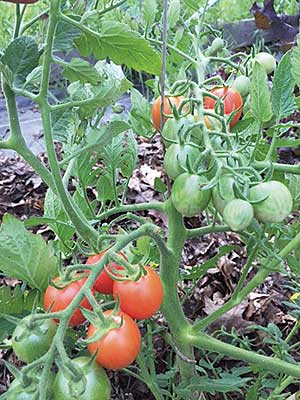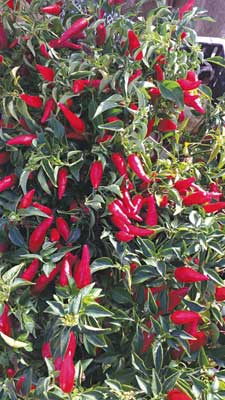 |
| ‘Pink Princess’ tomato is a selection from ‘Honey Drop’. Photo by Roberta Bailey |
 |
| ‘Matchbox’ pepper is now an open source selection. Photo by Roberta Bailey |
By Roberta Bailey
Photos by the author
Every farmer and gardener can be a plant breeder. Humans have dabbled with plants since they started harvesting and later cultivating them. You do not need acres of land or multiple degrees. Obviously, one can devote years of education and a lifetime career to breeding professionally, an honorable and fascinating endeavor, but anyone can dabble. That is how the plants used for breeding material and food got here. People saved their own seed. People selected the best plants for their needs.
Every time you save a seed, that plant is changing. It is adapting to your weather, your season, your cultural practices and your soil biome. You are joining a long chain of humanity that has collected seed from the plants that grew the best on their plot of ground, that gave the most food, survived the harsh winter, didn’t blow over in the wind or succumb to the disease that killed the others.
Basic selection is the simplest method of plant breeding: Grow your crop and save seed from the plants that best meet your needs. All this requires is observation and an interest in dabbling. You get to learn and eat or sell your mistakes, and your successes.
Meeting Goals
Different types of plants and different goals call for different approaches. Tomatoes, eggplant, peppers, beans and peas are self-pollinated. If you grow a variety of tomato with differences in the fruit, you can save from the plants that best meet your needs. All fruits on the same plant have the same genetic profile. You need to save from only one fruit per plant. If selecting for earliness, save from plants that ripen earliest. If selecting for taller plants, save from fruits of the tallest of those plants.
The cherry tomato variety ‘Honey Drop’ had a small percentage of incredibly delicious and sweet, pink-fruited plants. The grower saved seed from every plant that had pink fruit in order to keep the gene pool as diverse as possible. The next year he grew the seed, and most of the plants bore pink fruits. He saved from the best flavored ones with the highest yield. The next year all plants were pink and sweet and high yielding. That variety is now available as ‘Pink Princess’.
With a similar process you can also select for bigger fruit size, crack and disease resistance, and specific traits such as the ability to stand upright or extra leaf coverage. A few years ago I selected ‘Fish’ hot pepper back to having more striped variegation on its leaves and fruits. The population also included taller plants that seemed to set fewer fruits. I did not save seed from these.
Often, an heirloom variety will have off-types or plants that look different from the true varietal characteristics. You can select to keep the original expression of the variety or for traits you like better. When I was growing a few hundred plants of ‘Czech Black’ hot pepper for an organic seed crop, I observed that the fruit had a wide array of shapes and that some plants bore more heavily than others. I observed the overall shape of the crop and started saving my stock seed only from plants that represented the true shape of the fruit. By the next year most were true to shape. I started refining the selection for higher yield and sturdier plants. I sold the seed from all the plants but selected seed to improve the crop for future years. The entire seed crop improved quickly.
You can tailor crops to your needs. While focusing on a few traits, you will also be selecting for plants that thrive in your soil type, your weather, your cultural practices. Often, a commercially produced seed crop is grown in a climate very different from yours. It is sprayed repeatedly for disease and insect pressure. It may not be growing in healthy soil. By saving seed on your farm, you will likely have plants that will perform better and be healthier.
Save seed from plants that resisted disease and insect pressure. In future years, they will likely be more disease and insect resistant. When selecting for physical characteristics of a plant, changes occur within the first year or two. Disease and insect resistance can take longer, depending on whether these conditions are present from year to year. Resistance is also more complex genetically, as certain genes can attach themselves to others, but continued selection will produce results.
Working with Hybrids
Don’t be scared because a variety is a hybrid. Hybrids can be a source of excellent genetic material. They can feed your curiosity and provide many avenues for making your own varieties. Occasionally seed saved from a hybrid grows true to type right from the start.
In the simplest of hybrids, the variety was made by crossing two stable parent lines. When you save seed from that hybrid and grow it out the next season, plants will have a wide range of genetic combinations of the two original parents. Some will be identical to the hybrid parent. You have options. You can save seed from those most like the parent if you want to create a stable variety like that parent, or you can start saving from any of the other genetic combinations.
To stabilize a hybrid, keep saving seed from plants most like the parent. Each year more of your grow-out will resemble the parent type. Grow the original hybrid nearby to compare features of plant structure, fruit shape, flavor, etc. Having the original helps you interpret environmental influences on your crop. Seven or eight years may pass before all plants grow true to type. Then you have your own stable variety.
You can pursue other directions with the genetic breakout of your hybrid. A few years ago I wanted to stabilize ‘Chilipeno’, a hybrid from Europe that was no longer being produced. I loved its thick walls and elongated jalapeno shape. It had great flavor – and a lot of variability within the hybrid itself. When I saved the seed and then grew it the next year, none of the fruits looked like the original parent hybrid. I started to save from one pepper shape and plant yield that I liked. I kept saving and growing out my saved selections. In about the fifth year, I realized that I had lost the heat in my peppers. I went back and grew saved seed from the two previous years, and I started selecting for pointy fruit with sweet flesh and hot seeds and ribs, developing a second line that was pointy and fiery hot all the way through. You can save seed from a few peppers from each plant and sell the rest.
Now I will isolate the two lines by growing them in 4-foot-high tunnels covered in row cover. I will continue to save from plants with the desired traits. In a few years I will have two new varieties, adapted to my farm and my personal vision. If they prove to be consistent winners, I will try to interest a seed company. Usually I send seed and pictures to the company, which will grow it out and trial it. If the company likes it, it will contract for a specified amount of seed from the grower/breeder or another production grower.
Working with Cross-pollinated Crops
Many plants cross pollinate, including squash, most greens, brassicas, corn, carrots and most root crops. They require a larger population to maintain genetic integrity. If you save from just a few plants, insufficient genetic strength or diversity will be present to maintain the health of the plants, and they will not thrive. This is known as inbreeding depression. Always keep your populations as large as possible, with a minimum of 20 plants after selections are made. Wind-pollinated crops such as corn need populations of 200 or more.
One of the easiest ways to make a selected variety from an out-crosser that suits your farm or garden needs is to grow a large plot of a few varieties. Let them all grow together in a system called mass selection or “massing.” All the varieties cross with each other. Then grow as much of the seed as possible that you have saved from all the plants. Let this diverse gene pool grow from year to year. You’ll be fascinated to watch the population evolve. Or choose specific plant types from the whole and start to save that population. Over the years, with continued selection, it will stabilize and produce just the selected strain.
A few winters back I let 10 varieties of kale go to seed in our high tunnel. I gathered the seed by laying the plants and dried seed heads on a tarp and then walking on the plants. I planted that seed over the next few years. I had grown some crosses of a red kale and ‘Madeley’ kale (from Adaptive Seeds), a variety I liked for its hardiness, extreme productivity and large, rounded leaves. I saved seed from those plants separately. At this point they may have crossed with the other kales in the planting. The next season I grew the saved seed, and 70 of the plants that had red-tinged round leaves overwintered in the high tunnel. I saved seed from those that thrived through the winter. Now I continue to grow the seed and save from the reddest, tallest and hardiest of these plants. I am making kale that meets my farm needs in my high tunnel over-wintering conditions and in my heavy clay soil.
With kale, lettuce or spinach, don’t save seed from plants that bolt first, since you would be selecting for the trait of bolting early. Save seed from plants that are the last to bolt and that have other desired traits.
To work with root crops in New England and other areas where the ground freezes solid, dig the roots and store those with the most desirable traits in a well-marked crate in a root cellar. Early the next spring, set them out, spacing them a few feet apart. They will grow a large top with many umbels or branches of seed heads. Gather seeds as they dry, and store them. Because carrots will cross with Queen Ann’s lace, isolate these two by growing carrots in a screen house or where no Queen Anne’s lace grows.
Corn is wind-pollinated and must be isolated by miles from other varieties or grown with a different pollination timing. Growing one variety and saving enough seed for many years is a good solution.
Plants often produce far more seed than one can use in a single year. I store thoroughly dried seed in glass jars in the freezer. Much of it will last 10 years or more.
Squash, melon and cucumber species will cross with each other. You can grow one species at a time or learn how to pollinate by hand.
You can have your own seed, adapted to your farm’s microbiome and your specific plant needs. You don’t have to worry that your favorite variety is going to be dropped by a seed company. You can bring “local” to a whole new level – actually, back to a very ancient level.
About the author: Roberta Bailey raises garlic seed and seed of dozens of vegetable and flower varieties at MOFGA-certified organic Seven Tree Farm in Vassalboro, Maine. She is a long-time writer for The MOF&G and works for Fedco Seeds. The ‘Matchbox” hot pepper that she bred is one of 375 Open Source Seed Initiative (https://osseeds.org/) listings – i.e., varieties designated as Open Source by the people who bred them to make sure that the genes in at least some seed can never be locked away from use by intellectual property rights.
